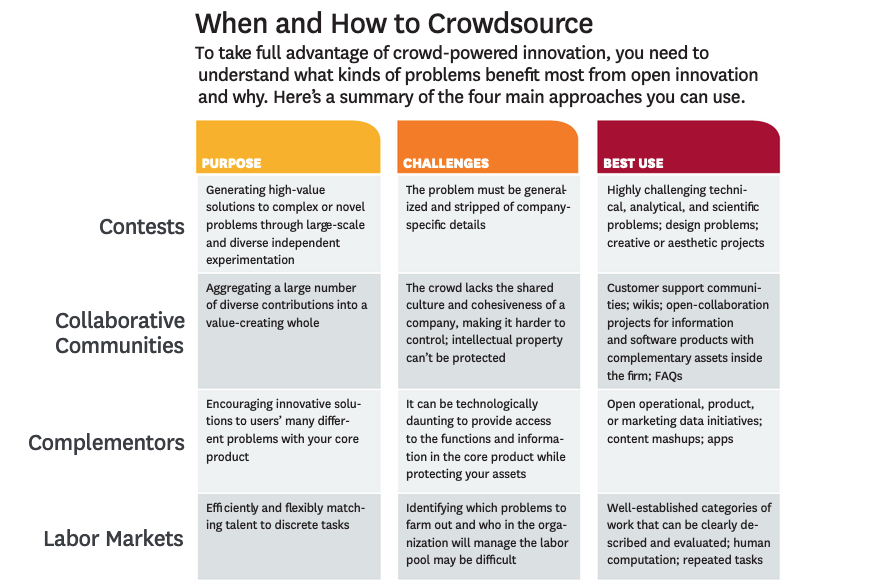- From Apple to Merck to Wikipedia, more and more organizations are turning to crowds for help in solving their most vexing innovation and research questions, but managers remain understandably cautious. It seems risky and even unnatural to push problems out to vast groups of strangers distributed around the world, particularly for companies built on a history of internal innovation.
- A number of questions arises: How can intellectual property be protected? How can a crowdsourced solution be integrated into corporate operations? What about the costs?
- These concerns are all reasonable, but excluding crowdsourcing from the corporate innovation tool kit means losing an opportunity.
- The study conducted by Kevin J. Boudreau and Karim R. Lakhani has identified when crowds tend to outperform internal organizations (or not). They outline four ways to tap into crowd-powered problem solving—contests, collaborative communities, complementors, and labor markets— and offer a system for picking the best one in a given situation.
Contests
- Contests, for example, are suited to highly challenging technical, analytical, and scientific problems; design problems; and creative or aesthetic projects. They are akin to running a series of independent experiments that generate multiple solutions—and if those solutions cluster at some extreme, a company can gain insight into where a problem’s “technical frontier” lies. (Internal R&D may generate far less information.)
- Explicit contractual terms and technical specifications must be created to ensure the proper treatment of intellectual property.
Crowd Collaborative Communities
- In June of 1998 IBM shocked the global software industry by announcing that it intended to abandon its internal development efforts on web server infrastructure and instead join forces with Apache, a nascent online community of webmasters and technologists.
- Organizations can assemble their own communities, but doing so may be difficult and time-consuming, especially when resources must be dedicated to curating the platforms.
Crowd Complementors
- The third type of crowd-powered innovation enables a market for goods or services to be built on your core product or technology, effectively transforming that product into a platform that generates complementary innovations.
- Consider iTunes, organized around Apple’s core mobile products—the iPod, the iPhone, and the iPad. Through iTunes, vast pools of geographically distributed developers create a staggering array of complementary innovations such as software apps and user generated podcasts.
Crowd Labour markets
- Whereas contests offer crowds rewards for coming up with solutions to specific problems, labor markets match buyers and sellers of services and employ conventional contracting for services rendered.
- The supporting platforms provide reputation and skills evaluations, bidding systems, procedures for recourse, monitoring technologies, and escrow services that keep payments in a third party account to minimize conflict between buyers and sellers.
The article “Using the crowd as an innovation partner” by Kevin J. Boudreau and Karim R. Lakhani is available at the following link: https://www.researchgate.net/publication/236223134_Using_the_Crowd_as_an_Innovation_Partner

